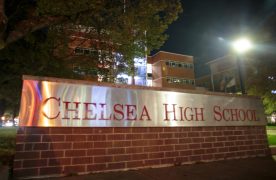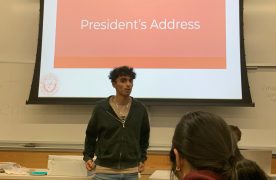The Boston University College Bowl team is well versed in questions about history, science and pop culture. However, the team does lack prowess in one area.
Finances.
Like many other organizations, the College Bowl has begun to feel the economic crunch as a result of campus institutions failing to cover the group’s entire operating cost. With the country in a recession, many outside organizations, which have helped in the past, are now failing to meet that extra need.
College Bowl Governor General Ellen Rosoff said the group has had problems with funding in the past.
‘Last year, the members of the teams that qualified and attended national tournaments had to pay for gas and food out of pocket,’ Rosoff said. ‘They earned prestige for the team and the school by going to nationals.’
This year, the BU bowl team hosted three tournaments and attended three others in the greater Boston area, allowing the team to walk or take public transportation, Rosoff said. However, there were added costs in preparing the home tournaments, and the Student Union Allocations Board only gave College Bowl between $200 and $300, according to Rossoff.
‘We had to pay for photocopying, prizes and breakfast for the teams with money from our account that we earned through hosting various tournaments last year,’ she said.
Rosoff said she found it a hassle to apply for funding from SUAB and other university organizations, citing ‘too much paperwork and not enough trust in the team officers to deal with our money.’
‘They used to give us what we asked for,’ Rosoff said. ‘Last year, they did not give us all of the funding we requested. It was hard for us, but we got through it.
‘We have to choose our battles wisely when we apply for funding and prioritize what we ask for,’ she said.
Student Union Executive Vice President Joe Rollin admitted there was paperwork, but said if the protocol was followed, funding ‘should not be difficult to request.’
‘Student groups have to go to the SUAB workshops and fill out the necessary paperwork in order to receive funding from SUAB,’ Rollin said. ‘To receive money from the Union, they must fill out the proper paperwork.’
Rollin also said the economy had absolutely nothing to do with groups seeking internal funding from the university.
‘With SUAB being allocated $2 more per student this year, there is more than enough money to go around,’ Rollin said. ‘The increase in student groups may be a cause that money would ever be tight.’
Rosoff agreed, saying she thought the recession had little to do with groups receiving more money, at least internally from university-sponsored organizations.
‘I think that the recession should have nothing to do with funding. Tuition keeps going up,’ Rosoff said. ‘SUAB should have more not less money to spread around, and we should get more funding than we do.’
In fact, Rosoff is correct about SUAB having more money than ever. This year, SUAB’s total allocation was $281,404.50, a huge increase due to $2 more per student, according to Rollin and Union Vice President of Financial Affairs Mike Bodek. The organization gave $81,684.14 to 93 student groups this semester, the two said.
Other than SUAB, student groups can receive funding from other outlets, such as the Student Union Senate, Union Executive Board, college governments, Residence Hall Associations or a related department at the university.
The Senate and Executive Board have been the two most active bodies in allocating funds this year, allocating nearly $8,000 to student groups between them. The Senate has allocated $3,980 to five student groups and the Executive Board has given $3,906 to eight student groups.
A major reason the Senate is able to give out so much funding, according to Bodek, stems from the Financial Review Board, a body of the Senate designed to listen to groups’ funding requests and then suggest an amount the Senate allocate to them. Bodek was the former chairman of the organization.
‘It’s to create more time for the Senate people at the meeting; the FRB listens to a very detailed fundraising proposal for the group,’ Bodek said. ‘It saves time and possibly money.’
Students can also look to outside areas for funding, including corporate sponsorships, including to Rollin. While Rosoff said the College Bowl did not apply for funding from outside organizations, some groups have, including the Community Service Center Siblings Program.
The Siblings Program took part in a fundraising program at Pizzeria Uno’s in Kenmore Square, where if people bring a coupon on a certain day and present it at the end of their meal, 20 percent of their check will be donated to the student organization. The Siblings Program coupons were used at many dinners during the night of their promotion, and the checks totaled $6,000, according to Uno’s manager Michael Radzyminski.
‘It’s basically so we can give something back to the community around us,’ Radzyminski said. ‘What we’re trying to do is bring some people into our restaurant who haven’t been here before and to raise our sales as well.’
In total, Uno’s donated $1,200 to the Siblings program, which Radzyminski said he thought was the largest total of the entire year. He said between six and eight groups have utilized the service this year, including a sorority who will use the fundraiser to raise money for the Ronald McDonald house tomorrow.
Other student groups, such as Dance Marathon, have sought corporate sponsorship from several organizations. However, the group has been unsuccessful in securing any sponsors so far, according to Remie Ferreira, one of the Dance Marathon Committee coordinators and the Union VP of Safety Services.
‘It’s a long, arduous process when you have big corporations, but we have letters and we have a packet made up that we sent to them,’ said Ferreira, a College of Arts and Sciences sophomore. ‘We send it to the community relations department of any corporation and what we do from there is badger them and work hard to let them know that we really care about it.’
Ferreira said the event was not receiving much help from corporate sponsors so far, but added that local sponsors have helped to make up the difference.
‘Going around locally isn’t hard at all,’ he said. ‘T. Anthony’s is a big contributor to the students, whether it’s monetary or product.’
While waiting for corporate funds, Ferreira said his group had also gone to SUAB and the college governments, and was planning to utilize funds from the Union, the Interfraternity Sorority Council and Camp Heartland.
Ferreira said his group was originally worried the country’s recession might affect the willingness of larger corporations to give to a student organization, but he said he believed the corporations would still begin to donate.
‘That was definitely something we were worried about,’ Ferreira said. ‘We haven’t heard back from any, but we’ll probably be getting a big flow and a large amount of donations in February and March before the actual event in April.’
But Ferreira said groups should not worry they should just creatively plan ways to make money and they’d be able to receive everything they needed to be successful.
‘I think that a savvy individual will be able to get all of their funds for a person who knows all the avenues it’s definitely not difficult to get them,’ Ferreira said. ‘It’s just a matter of knowing the institutions to go to.’
This is an account occasionally used by the Daily Free Press editors to post archived posts from previous iterations of the site or otherwise for special circumstance publications. See authorship info on the byline at the top of the page.












